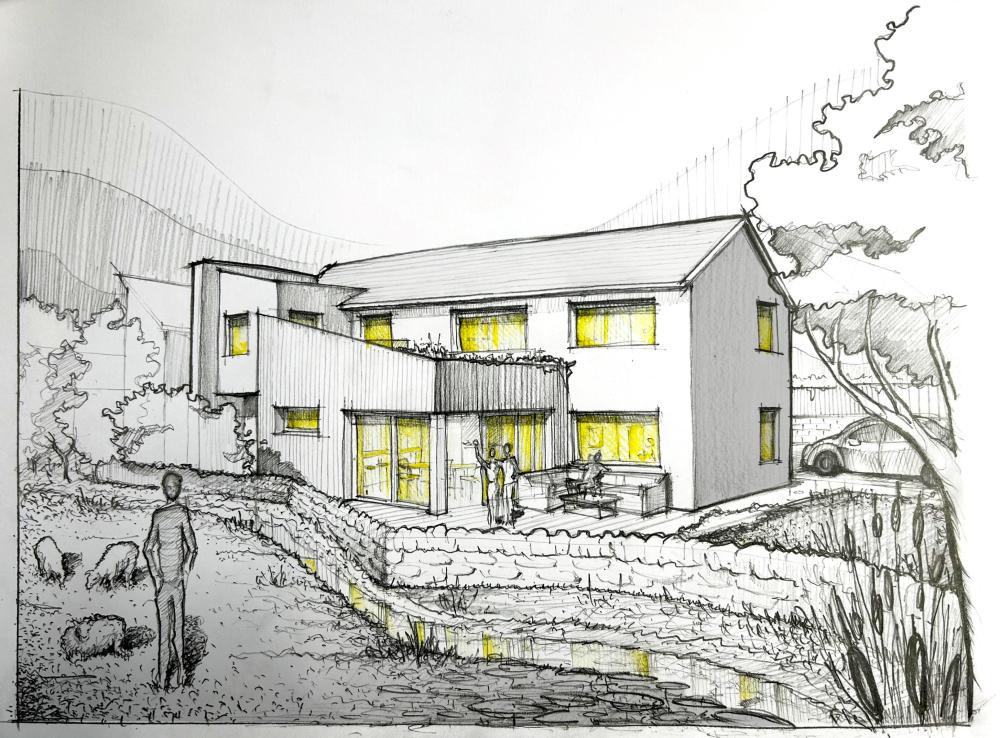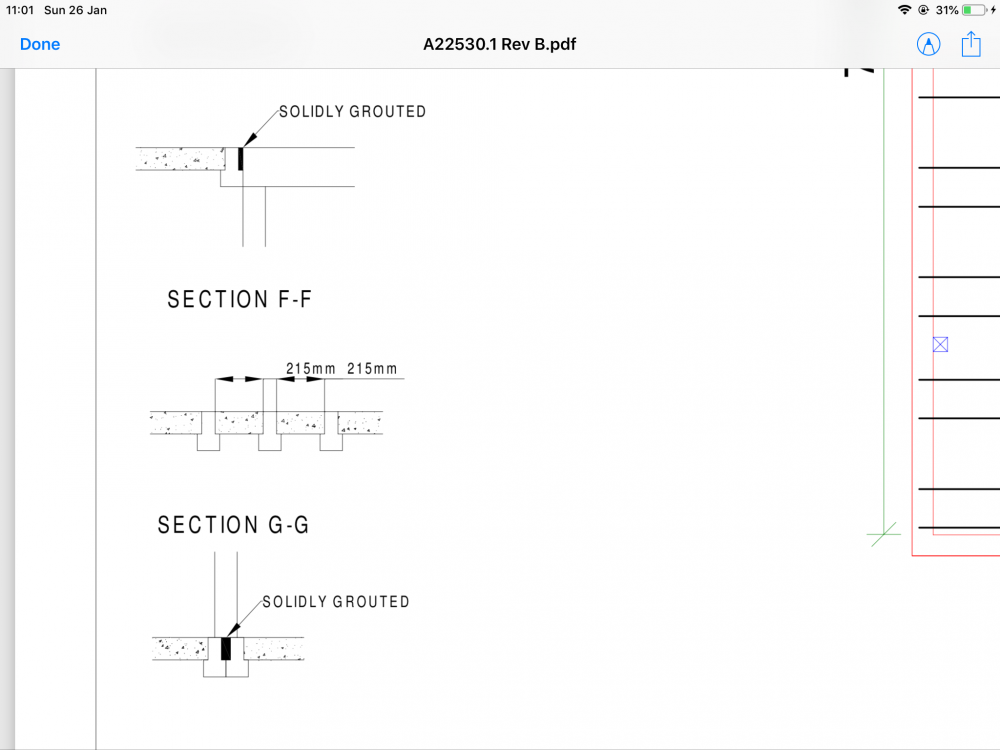Leaderboard
Popular Content
Showing content with the highest reputation on 07/23/23 in all areas
-
Depending on how long it takes you to finish I think moving in like that could potentially affect your VAT reclaim so check that out carefully as well.2 points
-
Not as simple as that, it’s actually a very big hole, so mid size excavator, lots of spoil to take away, gravel or concrete base, install tank, gravel or concrete surrounding. that’s just the tank, it then has to discharge somewhere, either a ditch or you need a drainage field. so loads more digging and drains and gravel. I did mine myself and I think the quotes I had were fair. good ground and a ditch to discharge to will remove a lot of cost.2 points
-
And there are ARB registered architect firms that can’t send you a single document that doesn’t have an error in it, well other than the contract and the invoices.2 points
-
All, or at least mostly true however... Unfortunately MCS have written their installation 'standards' into planning law. They shouldn't be there, if they belong anywhere they are part of building regulations. But that's not what has happened. Basically the government has outsourced writing the rules for permitted development to MCS. MCS is funded by a limited installation industry whose interests are, at least at present, aligned to low volume high price. It doesn't take a genius to work out what happens. The alternative is express consent which is down to LPAs. LPAs have been subject to 10plus years of council tax caps imposed by the government. It doesn't take a genius to work out that that frustrates their ability to hire people who have the skills needed to deal intelligently with new technology. Underfunded government, whether local or national, hasn't got a chance against well funded private vested interests. Underfunded government with politicians whose personal interests align with the worst of the vested interests even less so. That's what you get if you bang on about low taxes without regard to the need for public services, don't hold governments to high moral standards at the polling booth, don't evaluate the plausibility of arguments made by politicians and others, and have a press which is in bed with those who seek to prolong their personal privilege at the expense of the long term good of the population.2 points
-
2 points
-
This stuff I think. https://www.rawlinspaints.com/home/fire-retardant-paints/steel-intumescent-paint/5227-thermoguard-thermocoat-wi-ultimate.html The tin is in the wheelie bin. I'll go and check when back on site on Tuesday.1 point
-
Regular foam dries like the inside of a Crunchie, but the 330 is totally non-friable and you have to work hard to remove it where you've 'gone mad' with it. Remember to get a (Hozelock / other) spray bottle with a 50/50 mix of PVA/water, and spray everything liberally, immediately prior to applying the foam. The difference is night & day, as most do not realise that PU products are 'moisture cure'. Applying this into bone dry places results in the foam 'honeycombing' and not curing anywhere near as well / expanding effectively as it should.1 point
-
I thought you said "I think a bare bones 5kw monoblock could be under 2k eventually." Can you make up your mind? With the extra cost for the controller it's 2k without vat. I know it's a unicorn but there are HP in the close range 2k-2.5k bare bone. https://www.theheatpumpwarehouse.co.uk/shop/heat-pumps/air-source-heat-pumps/lg-therma-v-5kw-r32-monobloc-s-air-source-heat-pump-hm051mr-u44/ All included, I think.1 point
-
The upper 1/2 storey drains to adjacent land; pretty quickly. The lower 1/2 storey yes. Fortunately the flatlands are typically sand. Once you're through the silt/clay/peat cap it drains freely. 🙂 Not everywhere is the same; but passive house shouldn't make this assumption for you IMO.1 point
-
"This sounds like the stuff i have found in other other wall, i imagine it was done a long time back (can't really tell, only been in the house a couple of years) crumbles to nothing when you hold it. I was able to take it out in fairly large chunks. You can see some of it hiding in this small cavity, it's the white stuff protruding, comes out it largish chunks, but will crumble quite easily." Yours looks to have fared a great deal better than my former client's, then. If it is cohesive, as it seems to be, leave it, in my view. Do I need to worry if it is formaldehyde?" As I said, quite possibly not really. Most UF foam was done in '60's and '70's AFAIK and is very likely to have done all the off-gassing it wants to by now. Don't take my word for it; do an internet search.1 point
-
1 point
-
To be fair, this is for people 3 or so years out of uni. In a big practice they mat have no involvement in the business side, so this has to be a good idea. Says someone who is good at maths? A large proportion of our industry don't have an inherent feeling for quantities. And even more couldn't put an invoice together with retentions and VAT worked properly. Then there is 'setting out'. I wonder how people find it difficult. They think I'm being lucky or finnicky.1 point
-
Vaillant alone are making 500,000 air to water heat pumps and they are not a global major player. Air to water monobloc adds a plate heat exchanger and if you are lucky a circulation pump. No need for for the indoor unit that come with air 2 air. I paid £1300 for 6kW. It was on eBay from a dealer, they wouldn't be selling at a loss.1 point
-
As @Russell griffithssays. I know from discussing with digger driver/ some end users that they are not usually done properly. This isn't necessarily wilful bad work but through not understanding why the design detail matters. The bco doesn't usually get closely involved either. So I believe that 3/4 are installed incorrectly, (and so won't digest properly) and outfall to much undersized soakaways instead of drainage fields. Could be smelly. Hence £7k for a bodge and £17k properly. With a ditch adjacent the proper job cost can reduce.1 point
-
An hour from London? Plot with planning £450k. Plot with hope value £200k. They usually don't have services. London money keeps the prices high. Locals have no chance. Most are owned by big land owners who don't need the money, so no negotiating. Don't assume that self build is cheap. Your plan looks OK, but there is probably a lot that you don't know you don't know...yet.1 point
-
Check whether you’re in an area with a solution available, most I’ve come across wouldn’t even accept treatment plants yet.1 point
-
Have a look at EWI Store they do external insulation and the silicone render to match and can recommend an installer in your area which would then give the warranty. I believe their render is up market from K Rend https://ewistore.co.uk/?gclid=Cj0KCQjwn_OlBhDhARIsAG2y6zNNjisDZYjLv_qO1YE5UXtv1ZiLnyev9BmOg76A-zZaeuGcMcuWIDoaAgtZEALw_wcB1 point
-
https://www.theheatpumpwarehouse.co.uk/shop/heat-pumps/air-source-heat-pumps/samsung-5kw-r32-monobloc-air-source-heat-pump/1 point
-
Are you even sure that blockwork you have exposed is a cavity wall? It would not surprise me if on a 1960's house that was not just single block then the hanging tiles? I would not want the render to come right out to the face of the piers, I would want some small step back or are you intending to render over the brick pier as well (thus creating a joint in materials just waiting to crack?1 point
-
1 point
-
1 point
-
I am thinking is the opening is the original width of the window in the room before the extension and this was the cheap option to just keep the lintel that was there. It is probably possible to widen the opening and replace with a much longer and stronger lintel, but it won't be cheap or simple.1 point
-
Or do what we did, make Utility and downstairs WC all in one room. I could not find a way to make a WC and utility accessible from the hall without making the hall bigger to accommodate another door and waste space with corridors, or go through one room to get to the other, so I decided on just one room that contains washing machine, tumble dryer, sink, clothes airer and WC. Building control were happy with that, the space of the clothes airer is our potential future downstairs shower allocation and if we did fit a shower we would then partition it to a smaller utility room that you walk through to get to the shower room. But prefer it all open just now.1 point
-
1, you are doing UFH do you need an UFH pump and mixer? This could be deleted and use the circulation pump in the ASHP. Unless you intend to make lots of zones and install a buffer. Is she ok with guests walking through the utility to get to the toilet? Would it be better swooping WC and store around, so toilet access is from the hall.1 point
-
Plus labour to install I had a quote of £17,000 all in. just another cost. not really a problem there isn’t a house within a couple of miles of me connected to mains drainage. it’s certainly not a deal breaker.1 point
-
Hi @Dunc I believe that if you have digital thermostats and protect all electric cables through the insulation you can increase the insulation around the tank. Well, actually that's exactly what we did on our vented cylinder 2 years ago. But as @ProDave just commented about: we found out that insulating pipes to within an inch of their lives made a surprising difference. We have no problem with pump noise with either the primary or secondary circuit pumps. The recommendations are to keep everything, except the box with the fan, INSIDE the thermal envelope. I would recommend insulating external pipes really, really, well. Will you need a buffer tank? Your biggest running cost going forward will probably be for heating the building. The design of heating systems has become more and more complicated and more and more exacting over the last 100 years and ASHP's are at the forefront of this. In the middle of winter you may have the outside temperature at -5°C and you want the water heated to 55°C. If the only things between these temperatures on the outside pipes is a layer of copper and 13mm of foam good luck with that! Keep the external pipework to a minimum. I would design a section of the garage at the back right to be within the thermal envelope and fit the ASHP on the garage back wall connecting to all the heating, hot water gubbins there and get rid of the plant room and make an airing cupboard in the rearranged area with a small radiator. Good luck. Marvin.1 point
-
Completely agree. In our previous house the DHW tank, diverter valves, and main circulation pump were all in a big cupboard outside our bedroom door. Not specifically noisy but everything is noisy in the dead of night. This time everything is in a plant room in a separate part of the house. It does back onto the study which might eventually become a bedroom which isn’t ideal but it will only have occasional use. We have no pipework routed within our bedroom other than the MVHR ducting to the living room but that is under the floor of the coom wall that runs through the bedroom.1 point
-
My 2 pence worth to that: We have our DHW tank in the spare bedroom (one day I will build an airing cupboard around it) It does not give off excessive heat and does not overheat the bedroom at all. No further insulation of tank needed, BUT ensure ALL pipework connecting to the tank is well lagged with good thick well fitted insulation, that is where you will get a lot of heat loss if not done properly. We have a noise issue with the water circulation pump being a bit noisy. It is NOT an issue with where the pump is, but routing of pipes. In our case the pump is in a different room, but mu "mistake" was routing the main flow and return pipes from the ASHP under our bedroom floor. Regardless of where the circulating pump is located, it's gentle hum will be transmitted by the pipes. So keep the pump AND the pipes away from your bedroom. If I could do it again, the pipes would take a slightly longer route under our en-suite bathroom rather than under the bedroom. We set aside a "plant room" (room above the attached garage) but it ended up not really being used for that. The only thing in it is the MVHR unit, some electrical controls for the ASHP and the circulating pump. It turned out MUCH better to site the DHW cylinder in a location central to all points of hot water use, to shorten hot water pipe runs and quicken time for delivery of hot water to the taps. Try and plan a suitable cupboard for that central to all hot water taps. Call it "airing cupboard" on your plans.1 point
-
And before the air test, close off fan extracts (polythene and masking tape), and close any other vents and gaps. And be there during the test. The tester is likely to ask what number your are hoping for, so may be more helpful if it doesn't quite get there. No that sounds like a bad idea. Sorry you feel like that, but that doesn't help and probably isn't so. Nobody had overall responsibility but you, so best just get this sorted now. There is lots of knowledge here so keep asking. Have you any more info on the input numbers? The advice above is good. Your house is probably much better than many mass development units, but they know the tricks and have influence. There are lots of tick boxes in the sap assessment where one conservative assumption makes a big difference. I think my next move would be to chat to the assessor again. The windows are not going o be changed. What can be done free or more cost effectively? are there any assumptions you have had to make that could be looked at again? What Air change target am I after? Everyone, does anyone happen to know?. The suggestion by @ProDave is especially good if this can be fitted later...perhaps very much later.1 point
-
Everytime I read this it makes me so cross. You're absolutely right, any installation standards have no place in planning law. It's criminal that MCS have been allowed to write the permitted development planning rules. I think actually they might be the only non-governmental body to have been given the approval to do so. I can build a large extension as PD and the only people that care about HOW it's done (quite rightly) are Building Control.1 point
-
ATM I have an oil boiler. As mentioned elsethread I am still trying to agree a spec with >0 HP installers, and in any case am waiting for my planning application to be validated. So posts about the control of an HP based system are purely conjectural at this stage. I agree with the received wisdom to run on WC using the TRVs only as high temp backstop limit and as zone valves for rooms that are out of use (don't start!) But I also hope to have a thermal store which I plan to heat to 55C at the same times as the HW cyl is heating, this should act as a big heat sink and avoid the HP short cycling with the (small) coil, so avoiding the need to change the cylinder. I calculate that heating the TS to 55 off-peak will still be cheaper than running the HP on weather comp at peak rate. And if there is surplus PV it will be entirely free and a good way to store the energy which would otherwise be exported to the grid without any recompense.1 point
-
If you plan to let it all go silver its not really important. If you plan to paint it best avoid horizontal surfaces and sharp corners/edges and the paint will last longer. We have a lot of exterior oak treated with ozmo UV Protection oil to keep it honey colour and its the horizontal surfaces that go first. For the middle one I would screw up through 2 into 3. You can recess the screw head so it doesn't need to be very long. If you go for pressure treated soft wood I've found strimmers cut through the protection on fence posts and they rot out at ground level. Very noticeable as I have some posts that don't get strimmed and others that do. 9n some new posts I wrapped them them with heatshink sleeves designed for fence posts but they are messy and not sure if they work yet.1 point
-
IMO it's about unwanted heat loss and dew point. Aircon - always insulate else you'll get condensation / drips Domestic cold water - suggest insulating if it's in a bathroom for the same reason Heating primaries (before they ranch for space heat / hot water) - insulate to avoid summer heat gain Domestic hot water primaries (from branch to cylinder coil) - insulate to avoid summer heat gain Space heating primaries / pipework - I would say NO unless they will cause excess heat gain (tap dancing on UFH in a hallway for example) or you're using bits of insulation and then clamping around those to allow pipes to expand/contract without rubbing/squeaking Domestic cold water elsewhere - meh Domestic hot water - definitely the bits that are always hot such as a manifold above a cylinder that heats by thermosyphon; probably good practice to insulate the rest Cooling with a heat pump - now you do need to insulate your heating primaries as they become your cooling primaries @Nickfromwales?1 point
-
Yes, I was moved over in 4 days, still going through the change over process but am on Octopus, while the full transfer takes place which will take about 6 weeks.1 point
-
Some but not all thermostats have adjustable hysteresis. I think some also have anti cycling time delay built in. The overall effect is the same, you get slightly less precise temperature control. A thermal store or buffer tank stops the boiler short cycling but costs £. Another possibility is fitting a smaller jet in the burner. We did this after discovering our boiler was bit too big even in very cold weather. According to Grant the smaller jet is a bit more efficient as well. We haven't noticed issues with the smaller jet blocking. ..1 point
-
If you're disposing of the earth. Reread the description and I'm describing what folks do here in the cold flatlands. Digging out a half storey; building from below the frostline (which they'd need to do anyway); then banking the excavated earth up against the house so that ground floor ends up half a storey above the surrounding land. Free of mosquitoes. With a view. Free of water on the ground floor etc. In the cities there's also an argument for it. Half basements for the cars, pushbikes, strollers, electric wheelchairs etc. In the space that you've had to dig down to for footings. Aartments above them. Density the city without losing amenity. Does involve muckaway though. But meh if that building is still there in 100+ years. Also meh if it's that basement that saves you a from Russian invasion etc. Check out Finland for planning policies that consider legitimate military interests. They've got some of the world's most over specified underground parking/gyms/bats etc all in the name of good effing luck if you make it past the swamps sunshine.1 point
-
1 point
-
Once again and for the last time if you want to discuss interest rates then fill your boots in this topic. Having it out over what the government did and didn't do during COVID is not for this post . If you want to discuss that then maybe a self build forum ain't the place to have it.1 point
-
and I had to have 4 surveys through the summer and then a few weeks ago another bat survey followed the next day by a nesting bird survey then and then a destructive bat survey with the ecologist supervising the stripping of roof tiles. The only time anything was seen was when i left them alone for 30 mins. DO NOT EVER LEAVE THEM UNATTENDED.1 point
-
1 point
-
Because it isn’t worded as such. Which part of the “start within three years…” states you can or need to discharge that condition? Conditions worded prior to commencement/development/demolition/occupation are dischargeable conditions. To confirm commencement, you either submit a LDC application or some LPA’s may offer a “letter of comfort”.1 point
-
Thank you @saveasteading We have fulfilled each one of the items on the checklist above and were sure to take plenty of photos and videos of the works carried out to keep as evidence. (For anyone's (in the same position in the future benefit for reference)) after full payment settlement our BCO reviewed all of our structural engineer's, architect's plans & made us get an Energy Compliance report etc. and signed off all that as okay to commence prior to their first site visit to validate. That's a good idea to email them all to someone. Our appointed Building Inspector took many photos too - they have offered to send me their notes for the site visit, I expect that they will make reference to commencement and eagerly await those.1 point
-
As long as you have proof that the project has started all is OK. You don't need certificates. As as long as the bco has been appointed and has been to sitd to approve relevant works then you are OK. The only issue would be if someone wanted to make trouble and argue that you hadn't started in time. In that case you have proof in your correspondence and photographs ahat should end the matter I tend to send copies in an email, to a friend or colleague, or even myself as the email is dated proof. Checklist Bco appointed (fee paid?) Relevant work done Bco has visited and is OK with it. You have some record I'd just emphasise that it needs to be relevant work and not some trivial thing contrived for the purpose1 point
-
Have a look at section 56 of the Town and Country Planning Act 1990 (it's on line). That section sets out the time when development has begun. You seem to be relying on paragraph 4(c) "the laying of an underground main or pipe to the foundations, or part of the foundations of a building". I would suggest that you would have to take the pipe from the soakaway right up to the location of the proposed foundations, not just stick in one length of drain. I'm slightly cautious because argueably there are no foundations are there? If you are concerned that the LA may be awkward (if perhaps it was a contentested site) the most secure way is to dig just a small section of foundation trench, then there is no possible dispute because paragraph 4(b) is clear. Get that inspected, photographed (and then backfilled) and write formally to the LA with the evidence advising that works have materially started on site in accordance with Section 56. The whole hog would be a LDC but it would take a really difficult LA to try and overcome that evidence. Is there a reason that they would take such an extreme approach?1 point
-
thanks all. I guess all I wanted to know is whether I'll regret settling for Howdens when DIY Kitchens is so much better at literally the same price. In fact, I could get a painted kitchen for £300 more... as for a kitchen designer, I disagree. we're very hands on homeowners, we did our building regs drawings, our floor plans, we're not your typical customer who need to be told what can be done. besides, we spend a lot of time in the kitchen, with friends, and need to satisfy some OCD style needs regarding symmetry etc. any other tips welcome, thanks again!1 point
-
1 point
-
You only pay for, and install insulation once, you pay your energy bills every 3 months for the rest of your life. Which dollars would you choose!0 points
-
0 points
-
0 points
-
i dont wish to anger any structural engineers, but the majority would admit they are not specialist pre-stressed floor beam engineers (some are), they wont spend time calculating this product but use available technical information such as load span tables, these are actually conservative with regards to achievable spans. for example increased spans can be achieve when in design, this could be the difference between specified a 225mm when a 150mm will work, quite a cost saving IMO.0 points












